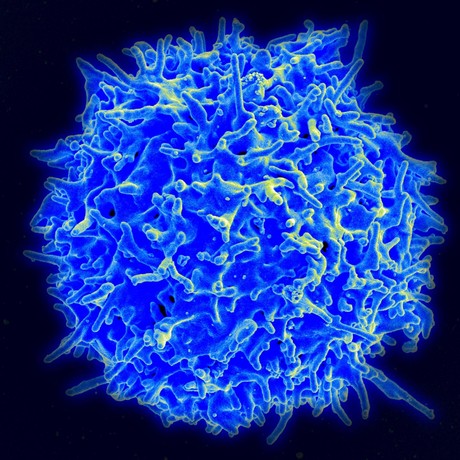Two-handed handshake that encourages cell suicide

Researchers have discovered a mechanism that eliminates T cells that pose autoimmune dangers.
Although the mechanisms are intertwined with biochemical processes, they also work mechanically, grasping, tugging and clamping, according to Georgia Institute of Technology researchers, who measured responses to physical force acting on these elimination mechanisms.
The mechanisms' purpose is to make dangerously aggressive, developing immune cells called thymocytes kill themselves to keep them from attacking the body, while sparing healthy thymocytes as they mature into T cells. Understanding these selection mechanisms, which ensure T cells aggressively pursue hordes of infectors and cancers but not damage healthy human tissue, could someday lead to new immune-regulating therapies. The study was published in the journal Nature Immunology.
Two-handed handshake
Usually, researchers pursue such mechanisms using chemistry experiments, but Georgia Tech's Cheng Zhu, who led the study, makes atypical discoveries via physical experiments to observe effects of forces between key proteins in living cells.
"Experiments where the proteins are isolated and used in chemical reactions in vitro miss this force dynamic," said Zhu, a Regents Professor in the Wallace H. Coulter Department of Biomedical Engineering at Georgia Tech and Emory University. "Before our work, force was not considered as a factor in thymocyte selection and now it is."
In this study, they discovered a loop of physical signals resembling a double-handed handshake that encourages cell suicide. It is described in further detail below.
Thymocyte death gauntlet
Like blood cells, human thymocytes are born in bone marrow, but they travel to the thymus, a small organ just below the neck, where they run a gauntlet of selection tests. Failing any one selection means death by cell suicide; passing all selections promotes thymocytes to T cells that depart the thymus to battle our bodies' foes.
One selection checks T cell receptors (TCR), which are on the thymocyte's membrane, to ensure they are properly formed then to see if they recognise self-antigens, ie, molecules that identify the body's own cells. Then another selection, called negative selection, tests TCRs to make sure they don't react too aggressively to self-antigens.
Cells that pass these checks then have TCRs that tolerate self-antigens yet react to enemy antigens.
"You don't want the cells with strongly grabbing receptor sites to turn against the body itself," said Zhu, whose study focused on negative selection.
Self-antigen shakes
In negative selection, other cells extend self-antigens on their membrane to interact with the thymocytes' T cell receptors. Those interactions seal the thymocytes' fate — advance or die.
Studying forces in those interactions revealed a new signalling loop with mechanical properties analogous to a two-handed grip and tug by the thymocyte.
The first hand would be the T cell receptor itself, and the other cell presenting the self-antigen would be like someone else's hand holding a special ball out to the T cell's first hand. The handshake begins as the self-antigen gives a signal to the T cell receptor.
If the TCR reacts too strongly to the self-antigen, the thymocyte adds the second, assisting hand coming in from the side to make a two-handed handshake. The additional hand is a lever called CD8 (cluster of differentiation 8), which connects to key mechanisms inside the thymocyte and is considered part of the TCR site.
Suicide handshakes
For about two weeks in the thymus, multiple T cell receptor sites engage in one- or two-handed handshakes, which send signals into the thymocyte that make it either mature into a T cell or commit suicide.
The researchers found that the two-handedness markedly resisted the force applied to break the grip between the T cell receptor and the self-antigen, thus prolonging the duration of the handshake. A long grip sent signals for the thymocyte to die.
"That's the study's elegant finding," Zhu said. "That the force is significant for the selection to work."
New signalling loop
The researchers also made the novel discovery that CD8's handshake participation constitutes a signal coming from inside the thymocyte back out to the self-antigen in answer to its initial signal. "The inside-out return signal had not yet been reported for this T cell receptor," Zhu said.
Together, the outside-in and inside-out signals create a feedback loop that perpetuates the handshake — self-antigen touches receptor; receptor fires signal into cell and interacts with self-antigen too aggressively; inside cell membrane, signal pulls CD8 closer; outside cell membrane, CD8 strengthens handshake; when the self-antigen slips a bit, the double-handed grip can coax it back into the receptor, kicking off another signal, restarting the signalling cycle again and again; many feedback loops trigger cell suicide.
Pancreatic cancer hijacks metabolism switch to help it spread
Pancreatic cancer hijacks a molecule known for regulating physiological processes, such as food...
Novel antibiotic activates 'suicide' mechanism in superbug
Researchers have discovered a new class of antibiotic that selectively targets Neisseria...
Modifications in the placenta linked to psychiatric disorders
Schizophrenia, bipolar disorder and major depression disorder are the neuropsychiatric disorders...




